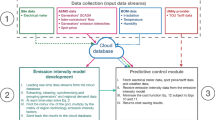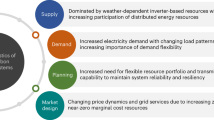Abstract
Today energy load forecasting is used by retailers to predict their future energy needs and address them in cost-effective ways. However, with the prevalence of the smart grid, accurate forecasting is becoming increasingly important, as the stakeholder base expands and differentiates by transforming to active prosumers who make their own forecasting and take advantage of the new smart grid capabilities for addressing excess or shortage of energy. For instance, they can benefit from participation in demand-response programs, or more futuristic such as local energy marketplaces. To take advantage of such opportunities, controllable energy signature in order to gain predictability is of key importance. We present here an empirical approach towards understanding how the predictability of a stakeholder can be improved through the availability of a variable storage. The guiding question is to investigate the relevance of capacity sizing for absorption of the intra-day forecast errors. The increase of variable storage in existing facilities such as that offered by the presence of electric vehicles in a building’s charging stations, poses new potentially cost-effective ways that facility managers can consider in the effort to maintain control of their infrastructure’s energy signature. Here we show, in a step-by-step approach, how intra-day energy forecast errors of a building, impact the overall capacity variation required to absorb them, and how proper storage shaping can assist. Although the approach is empirical, the same steps may be applied in other similar cases.












Similar content being viewed by others
References
IFMA Foundation, Technology for Facility Managers: The Impact of Cutting-Edge Technology on Facility Management. In: Teicholz, E. (ed.) Wiley, Somerset (2012)
Ilić, D., Karnouskos, S., Goncalves Da Silva, P., Detzler, S.: A system for enabling facility management to achieve deterministic energy behaviour in the smart grid era. In: Procedding of the 3rd International Conference on Smart Grids and Green IT Systems (SmartGreens), Barcelona, Spain, 3–4 Apr (2014)
Mathieu, J., Price, P., Kiliccote, S., Piette, M.: Quantifying changes in building electricity use, with application to demand response. Smart Grid IEEE Trans. 2(3), 507–518 (2011)
Lamparter, S., Becher, S., Fischer, J.-G.: An agent-based market platform for smart grids. In: Proceedings of the \(9^{\rm th}\) International Conference on Autonomous Agents and Multiagent Systems: Industry track, ser. AAMAS ’10. Richland, SC: International Foundation for Autonomous Agents and Multiagent Systems, pp. 1689–1696 (2010). [Online] Available: http://portal.acm.org/citation.cfm?id=1838194.1838197
Karnouskos, S.: Demand side management via prosumer interactions in a smart city energy marketplace. In: Proceeding of the IEEE International Conference on Innovative Smart Grid Technologies (ISGT 2011), Manchester, UK, Dec 5–7 (2011)
European Commission: SmartGrids SRA 2035—strategic research agenda. In: European Technology Platform SmartGrids, European Commission. Technical Report, Mar. 2012 (2012). [Online] Available: http://www.smartgrids.eu/documents/sra2035.pdf
Sevlian, R., Rajagopal, R.: Value of aggregation in smart grids. In: Smart Grid Communications (SmartGridComm). IEEE International Conference on 2013, pp. 714–719 (2013)
Backer, D.: Power quality and asset management the other “two-thirds” of AMi value. In: Rural Electric Power Conference, 2007 IEEE, May 2007, pp. C6–C6-8 (2007)
Goldberg, M.L., Agnew, G.K.: Measurement and verification for demand response. DNV KEMA Energy and Sustainability, Technical Report, Feb 2013 (2013)
Ilić, D., Goncalves Da Silva, P., Karnouskos, S., Jacobi, M.: Impact assessment of smart meter grouping on the accuracy of forecasting algorithms. In: Proceeding of the 28th Annual ACM Symposium on Applied Computing (SAC), SAC ’13, pp. 673–679. ACM, New York (2013). doi:10.1145/2480362.2480491
Ilić, D., Karnouskos, S., Goncalves Da Silva, P.: Improving load forecast in prosumer clusters by varying energy storage size. In: IEEE Grenoble PowerTech 2013, Grenoble, France (2013). http://diktio.dyndns.org/files/2013_PowerTech.pdf
PJM: PJM Manual 18: PJM Capacity Market. In: PJM (www.pjm.com), Technical Report, Nov. 2013 (2013). [Online] Available: http://www.pjm.com/media/documents/manuals/m18.ashx
Genoese, F., Genoese, M.: Assessing the value of storage in a future energy system with a high share of renewable electricity generation. In: Energy Systems, pp. 1–26 (2013)
Divya K., Østergaard, J.: Battery energy storage technology for power systems—an overview. In: Electric Power Systems Research, 79(4), pp. 511–520 (2009). [Online] Available: http://www.sciencedirect.com/science/article/pii/S0378779608002642
Alimisis, V., Hatziargyriou, N.: Evaluation of a hybrid power plant comprising used EV-batteries to complement wind power. Sustain Energy IEEE Trans 4(2), 286–293 (2013)
Peng, T.M., Hubele, N., Karady, G.: Advancement in the application of neural networks for short-term load forecasting. Power Syst IEEE Trans 7(1), 250–257 (1992)
Cho, M., Hwang, J.C., Chen, C.-S.: Customer short term load forecasting by using arima transfer function model. In: Energy Management and Power Delivery, 1995. Proceedings of EMPD ’95, 1995 International Conference on, vol. 1, pp. 317–322 (1995)
Zhu, S., Wang, J., Zhao, W., Wang, J.: A seasonal hybrid procedure for electricity demand forecasting in china. Appl. Energy 88(11): 3807–3815 (2011). [Online] Available: http://www.sciencedirect.com/science/article/pii/S0306261911002960
Pinson, P., Papaefthymiou, G., Klockl, B., Verboomen, J.: Dynamic sizing of energy storage for hedging wind power forecast uncertainty. In: Power Energy Society General Meeting: PES ’09. IEEE 2009, pp. 1–8 (2009)
Sanchez-Martin, P., Sanchez, G., Morales-Espana, G.: Direct load control decision model for aggregated EV charging points. Power Syst. IEEE Trans. 27(3), 1577–1584 (2012)
Acknowledgments
The authors would like to thank the European Commission for their support and the partners of the EU FP7 project SmartKYE (www.SmartKYE.eu) for the fruitful discussions.
Author information
Authors and Affiliations
Corresponding author
Rights and permissions
About this article
Cite this article
Ilić, D., Karnouskos, S. Addressing energy forecast errors: an empirical investigation of the capacity distribution impact in a variable storage. Energy Syst 5, 643–656 (2014). https://doi.org/10.1007/s12667-014-0119-3
Received:
Accepted:
Published:
Issue Date:
DOI: https://doi.org/10.1007/s12667-014-0119-3




